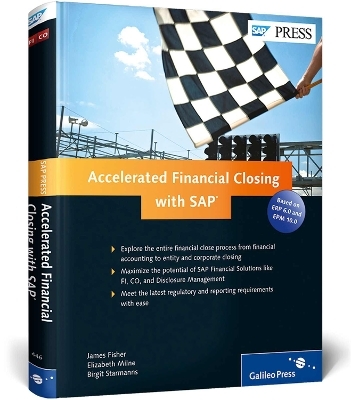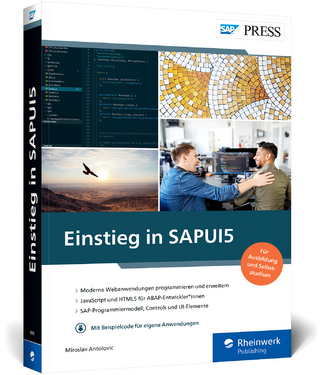
Accelerated Financial Closing with SAP
SAP Press (Verlag)
978-1-59229-446-6 (ISBN)
- Titel ist leider vergriffen;
keine Neuauflage - Artikel merken
James Fisher is Vice President of Product Marketing for Analytics at SAP, where he is a key stakeholder in solution strategy and is responsible for go-to-market strategy, positioning and messaging, demand generation and events, and roadmap communications. He has more than 16 years of experience in the analytics, performance management, and finance industry. Prior to his current role, James was responsible for solution marketing for SAP's entire portfolio of finance solutions, including Enterprise Performance Management and SAP ERP Financials, and he played a key role in the expansion of SAP's portfolio of financial close solutions. He joined SAP with its 2008 acquisition of Business Objects, where he lead EPM solution marketing, and he held solution marketing, global communications, and EMEA field marketing positions with Cartesis, a Paris-based EPM company subsequently acquired by Business Objects in 2007, which specialized in the consolidation and reporting market.Previously, James held marketing and consulting positions with PwC, in its Enterprise Group Reporting Services team, where he supported a number of global fast-close projects, and at KPMG, where he was a tax consultant. James has a business and finance degree from Kingston University in the UK and a Professional Qualification from the Chartered Institute of Marketing.
Foreword. 15
Preface. 19
Acknowledgments. 23
1. Introduction to the Financial Close. 25
1.1. The Business Case for a Fast High-Quality Close. 26
1.2. Components of the Financial Close. 32
1.3. How Fast Is Fast?. 33
1.4. Barriers to a Fast, High-Quality Close Process. 36
1.5. Summary. 40
2. Creating an Action Plan for Improving Your Financial Close. 41
2.1. Vision, Benchmarking, and Sponsorship. 42
2.2. Quick Wins. 48
2.3. Big Wins. 54
2.4. Continuous Improvements. 57
2.5. Summary. 59
3. Information Management. 61
3.1. Defining Data and Information. 63
3.2. Master Data Management. 64
3.3. Transactional Data Management. 67
3.4. Summary. 75
4. The General Ledger and Subledger Close. 77
4.1. SAP ERP Financials Concepts. 77
4.2. The General Ledger Close. 83
4.3. The Accounts Payable and Accounts Receivable Close. 88
4.4. Asset Accounting Close. 91
4.5. Inventory Management. 94
4.6. Reporting. 100
4.7. Summary. 102
5. The Financial Close in Controlling. 103
5.1. Cost Element Accounting. 105
5.2. Cost Centers. 110
5.3. Internal Orders. 115
5.4. Project Systems. 116
5.5. Product Costing. 119
5.6. Profitability Analysis. 124
5.7. Profit Centers. 127
5.8. Year-End Closing. 128
5.9. Reconciliation Between the FI and CO Modules. 129
5.10. Summary. 129
6. Entity Close Management. 131
6.1. Plan and Prepare the Entity Close. 132
6.2. Execute the Entity Close. 134
6.3. Customer Story: Dow Chemicals' Faster, Less Costly Financial Close Process with SAP Solutions. 136
6.4. Monitor the Entity Close. 137
6.5. Summary. 139
7. Enhanced Internal Controls for Better Compliance. 141
7.1. Access Risk Management. 144
7.2. Identifying Controls across a Business Process. 148
7.3. Audit Management. 151
7.4. GRC Analytics. 153
7.5. Summary. 156
8. Intercompany Reconciliation. 157
8.1. Defining Intercompany Reconciliation. 157
8.2. SAP Solutions for Intercompany Reconciliation. 158
8.3. Managing the Intercompany Process. 161
8.4. Faster, Collaborative Intercompany Reconciliation with SAP Intercompany. 163
8.5. SAP Intercompany Deployment Options. 165
8.6. Security and Configuration. 167
8.7. Summary. 168
9. Financial Consolidation. 169
9.1. Data Collection. 171
9.2. Processing Data. 183
9.3. Differentiation between Consolidation Solutions. 196
9.4. Starter Kits. 204
9.5. Summary. 210
10. Disclosure Management and XBRL Filings. 213
10.1. Collect Information from Source Systems. 217
10.2. Manage Financial Statements and Reports. 224
10.3. Collaboration and Workflow. 228
10.4. Publish Disclosure Statements and Reports. 234
10.5. Create and File XBRL Statements. 236
10.6. Summary. 243
11. Financial Reporting. 245
11.1. Reporting Requirements. 245
11.2. Reporting Delivery Methods. 254
11.3. Summary. 258
12. The Future of Finance and Its Impact on the Financial Close. 259
12.1. Economic Environment and the Role of Finance. 259
12.2. Financial Operations. 262
12.3. Managing Stakeholder Expectations. 265
12.4. Ensuring Regulatory Compliance. 271
12.5. Summary. 275
13. Conclusion. 277
Appendices. 281
A. Glossary. 283
B. References. 287
C. The Authors. 289
Index. 291
| Erscheint lt. Verlag | 25.11.2013 |
|---|---|
| Verlagsort | Maryland |
| Sprache | englisch |
| Maße | 175 x 228 mm |
| Themenwelt | Mathematik / Informatik ► Informatik ► Netzwerke |
| Informatik ► Weitere Themen ► SAP | |
| Wirtschaft ► Betriebswirtschaft / Management ► Finanzierung | |
| Schlagworte | Account management close • Asset accounting close • Disclosure management • Financial consolidation • General close • Intercompany Reconciliation • Inventory management close • Process controls • Process Governance • Sub-ledger |
| ISBN-10 | 1-59229-446-4 / 1592294464 |
| ISBN-13 | 978-1-59229-446-6 / 9781592294466 |
| Zustand | Neuware |
| Informationen gemäß Produktsicherheitsverordnung (GPSR) | |
| Haben Sie eine Frage zum Produkt? |
aus dem Bereich


